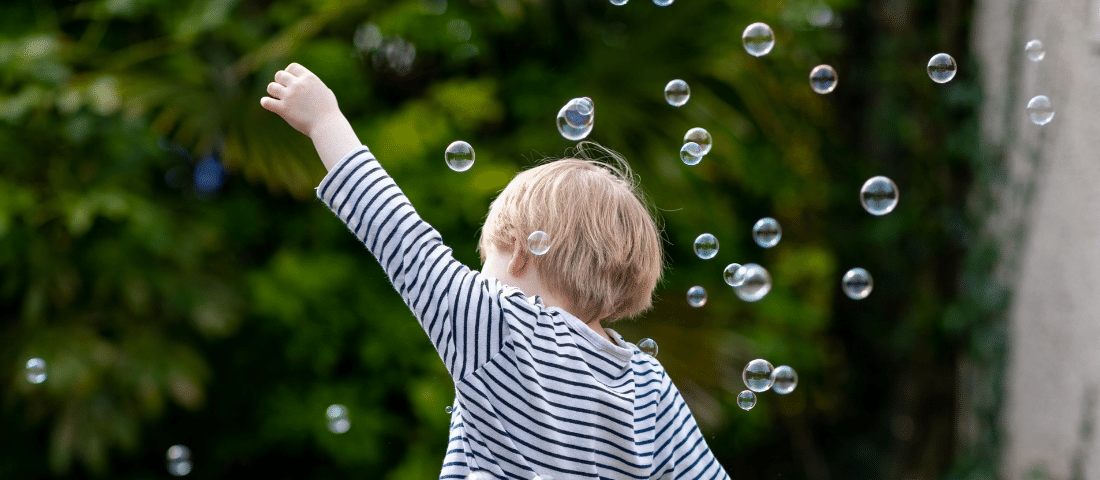Sensory play helps young children learn about the world around them and how it works. These sensory experiences spur fundamental physical, mental, social, and behavioural development at a critical age.
Exploring the world is something that children will naturally do. Sensory play in classroom or home settings, therefore, is about leveraging those instincts to catalyse key developmental indicators (KDIs) that contribute to healthy brain development.
In this article, we’re going to share why sensory play is key for natural development and how to plan ahead to include it in your childminder curriculum. We’ll also dive into several sensory play activities you can use, and how and why they benefit children in the early years.
Table of contents
- Why sensory play is key for natural development
- Plan ahead for the curriculum (and complete risk assessments)
- 1. Playdough
- 2. Playing with food
- 3. Growing plants
- 4. Sensory bin
- 5. Sensory bottle (calming bottle)
Why sensory play is key for natural development
Sensory play leverages young children's primary senses (sight, sound, smell, taste, touch, and balance) to stimulate brain development. By encouraging children to explore and feed their brains with new discoveries and experiences, so to speak, you help to strengthen their neural pathways.
Strong neural connections lay the foundation for critical brain development, which helps children cultivate valuable life skills that stretch into adulthood. These include cognitive growth, language development, decision-making skills, sensory processing, enhanced memory functioning, and more.
For example, developing sensory skills contributes to a child’s ability to pick something up, hold onto it, examine it, and subsequently understand what it is. Critically, sensory processing applies not only to material objects but also helps young children learn how to interact with other people.
Playing with objects and various new materials further help children to “receive, perceive, and integrate sensory information with motor responses”, according to this scientific study. In effect, the ability to explore, practice, and refine skills through sensory play lays the framework for complex thinking and physical and social growth.
When a child explores sand and water, for example, they are exposed to many different characteristics, such as:
- Temperature (cold, warm, hot)
- Material properties (solid, liquid, wet, dry)
- Consistency (textured, slimy, smooth, and how they change when mixed together)
Playfully interacting with sand and water is a means of active learning and stimulates a child’s senses. Children are discovering firsthand what the materials feel like, smell like, and look like, how they act when mixed together, how strong or weak they are, and so on.
At its most basic level, sensory exploration can help children develop motor skills. As they touch and feel the materials, they are beginning to understand voluntary, controlled movement, which leads to purposeful action. If touching the sand feels exciting and fun, a young child will be driven to repeat the action and subsequently enhance their motor skill functionality.
To make the play more complex, you can add even more materials to the sensory table, like tubes or boxes. This will help children achieve more learning outcomes from the Early Years Foundation Stage (EYFS) guidelines, such as classification and sorting (e.g. separate the hard and soft materials), problem-solving (e.g. get the stuck wet sand out of the tube), and critical thinking (e.g. transport water from the bucket to the sandbox with minimal spillage).
As you can see, the benefits of sensory play, especially at a young age, include brain and critical life skills development. The trick is understanding how to leverage sensory play for the children that you care for in your unique childminding setting.
Plan ahead for the curriculum (and complete risk assessments)
The best way to ensure you’re providing the right sensory play for your children is to plan ahead.
This will help you cover all of the required areas of the curriculum based on EYFS guidelines. It also ensures that you have the necessary materials on hand, the time to set up your space to avoid mess, and can conduct any necessary risk assessments.
According to the EYFS framework, you must have an outdoor play area, or if that isn’t possible, conduct outdoor activities every day. As sensory play can get quite messy, outdoor play is probably your best bet (though some sensory activities are suited for indoor spaces, too).
The EYFS framework further stipulates that you conduct a risk assessment to ensure that no child in your care is exposed to any risks. And, that you have a plan in place should an unexpected risk arise.
If one of your sensory play exercises involves food, for example, but a child in your care has strict dietary requirements, you should have a plan in place to ensure that child does not accidentally consume food they’re allergic to.
Of course, you should avoid bringing potentially dangerous food into the play area in the first place. But, to be extra careful, you should also have a plan in place in the event that the child does in fact get access to and put unauthorised food in their mouth.
Thinking ahead like this and planning for every possible scenario will help to not only ensure your childrens’ safety but also lend for a more comfortable, relaxed environment. If you feel secure in the sensory play activities you’re running and feel prepared to deal with every possible outcome, you’ll be able to create a higher-quality environment that lends itself to tons of fun and development through play.
Now that you know why sensory play is important and how to prepare for it, let’s get into five specific activities that you can run in your childminder home.
1. Playdough
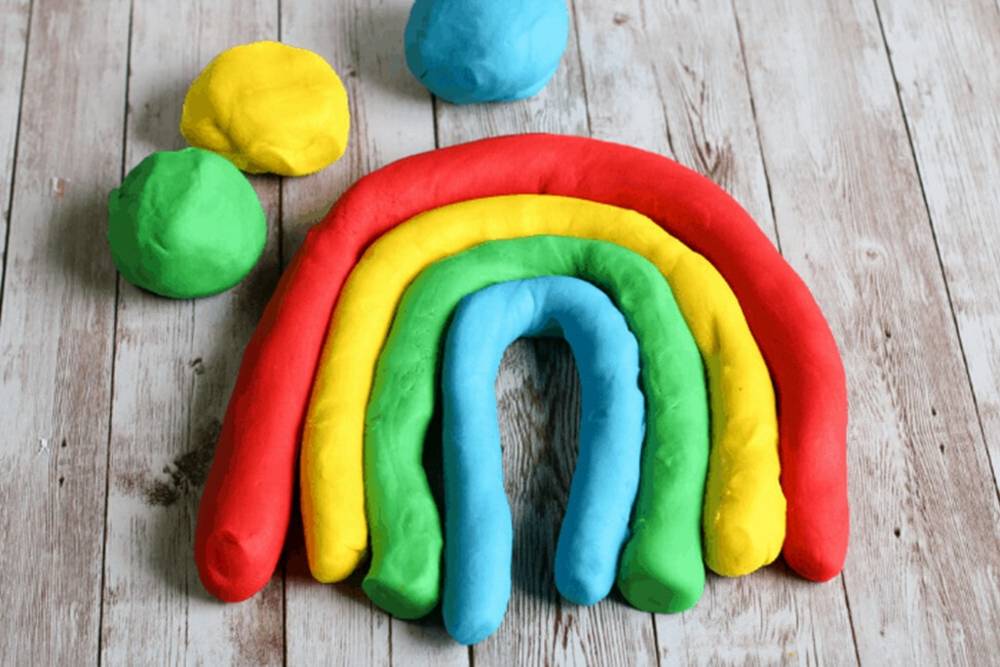
Image source: Life over C’s
Playdough is great for helping children develop motor skills, muscle strength, and creativity.
With playdough, children can squeeze, shape, pinch, squish, and pull, which is a great way to develop fine motor skills and improve hand-eye coordination.
Not to mention, it’s a fantastic way to spark imagination, as children can shape the playdough into anything they want and bring their ideas to life.
What you need for playdough activities
- The playdough itself: You can either make homemade playdough or buy it in a store.
- Tools for shaping the playdough: This will allow the children to shape the playdough into different patterns or cut one long piece into several. Of course, these tools must follow safeguarding guidelines, so cutting tools should be plastic silverware, ice cream sticks, or plastic cookie cutters.
- Things to spark imagination: This might include natural objects to add to the imaginative scene, like rocks or shells, or plastic toys.
Example of a playdough activity
Give each child an equal size of playdough and a plastic placemat to keep the surface clean. Then, show them how to roll the playdough into a ball, stretch it out, and flatten it down.
Encourage them to make whatever pattern comes to mind. For example, they could stretch it out and poke it with a plastic fork to make a pattern in a line. Then, put a toy car on it and pretend they’re driving on a road.
What will the children be learning?
This activity allows children to use creativity and imagination to shape the playdough in different ways. They will take initiative to form (literally) ideas about their own world.
The children can also identify and create patterns with the playdough, and express themselves through the shapes and scenes they create.
2. Playing with food
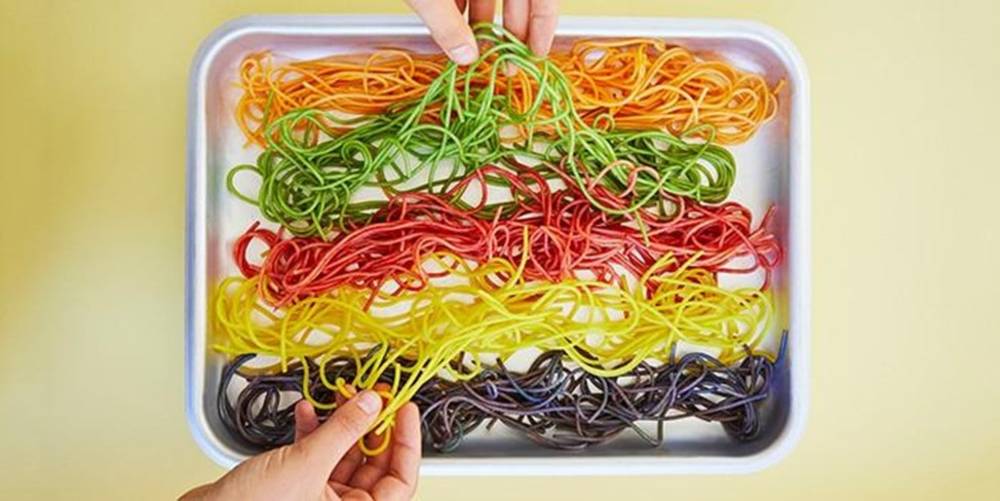
Image source: BBC Good Food
As we mentioned earlier, before you incorporate food into your setting, make sure that it’s safe and conduct a risk assessment. If you feel comfortable and ready, proceed to this fun activity!
Playing with food can be a lot of fun, but of course, food play is messy play. That said, allowing little ones to play with food (and taste it if it’s taste-safe) is a great way to let them explore textures, tastes, and smells.
Depending on the type of play, food play can help children develop fine motor skills, learn new vocabulary, explore new shapes and colours, and gather knowledge about the natural and physical world.
What you need for food play activities
- Food: This can be whatever you like! Sensory play ideas include spaghetti, jelly, oatmeal, cereals, rice, marshmallows, pretzel sticks, or a baked dough or frosting that you make yourself.
- Condiments and colouring: To add some colour and fun into the mix, make sure you have some food colouring and condiments handy. Other ideas include edible paint, sugar cubes.
- Things to spark imagination and construction: Buckets or bowls to keep the food in one place, trays to keep wet food in place, sand toys, plastic cutlery.
Example of a food play activity
Cook spaghetti and put a handful into a bowl for each child. Then, add food colouring and watch the children’s eyes pop in amazement as the colours change. Then, have them dig into the spaghetti with their hands to get a sense of the texture and consistency.
Next, hand out a different food dye colour (or do it yourself if your children are too young) and add it to the bowl. The children can watch how the colours change again, and how mixing them together makes them lose their original colours and form brand new ones.
As they play, the children can stretch, squeeze, or twist their worms to create new shapes and sizes.
From there, you can add new elements to the mix. This could be pretzel sticks or marshmallows for construction. Have the children construct new shapes and scenes by layering the pasta, pretzels, and marshmallows together.
What will the children be learning?
This open-ended activity is all about exploration and imagination. The idea is to boost curiosity and encourage them to act out their fantasies. Perhaps the spaghetti pieces are worms or snakes. Or, maybe the spaghetti is grass and the marshmallows and pretzel sticks are people walking or lying on it.
There are endless possibilities when it comes to food play. In essence, your children will be learning about the world and improving fine motor skills in the meantime.
3. Growing plants
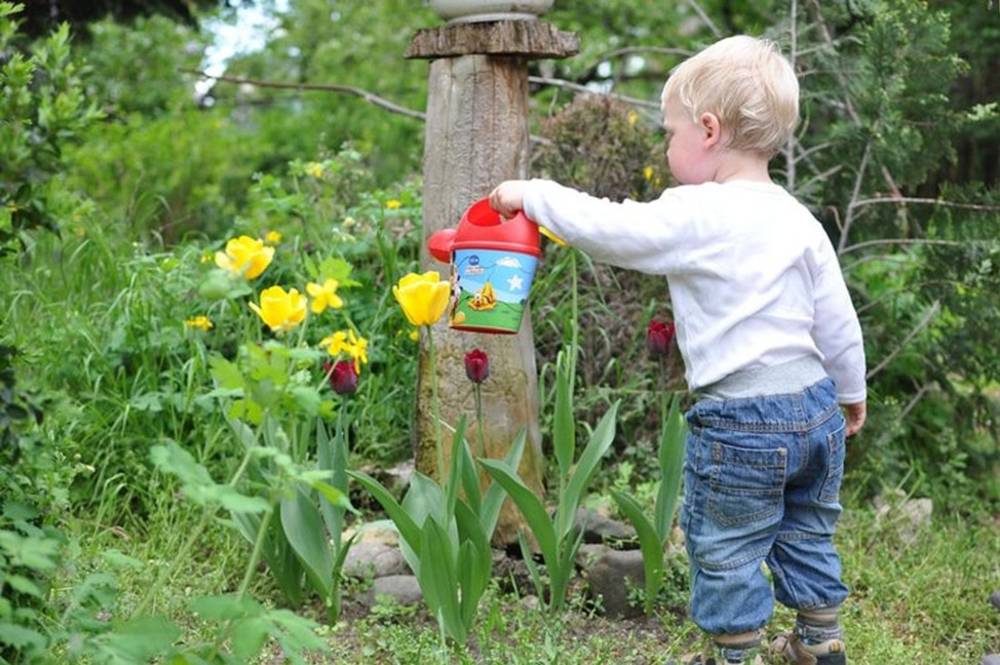
Image source: Michigan State University
Growing plants is a great way for children to understand the natural world around them. Additionally, playing in the dirt is one of the most natural things a child can do. It’s calming, relaxing, and is a great muscle-building activity.
Plants specifically are part of the circle of life. Children can learn that watering them makes them grow. They can also see that plants come in a variety of different colours, shapes, sizes, and textures and that they are food for both humans and other creatures.
If your plants are outside, they’ll also see how they blow and move in the wind, create shadows, change with seasons, and attract natural creatures like insects or birds. All of this contributes to an understanding of the natural world and the greater environment.
What you need for growing plants
- A variety of plants: Whether you have a big garden, a small patio, a balcony or even no outdoor space of your own, there are ways to grow plants. No matter your setting, the more variable the plants are, the better. This way, kids get to see that there are a lot of different plants in the world and explore tons of different textures, colours, and sizes.
- Fun pots: To make them a bit more fun, you can plant in traditional pots as well as non-traditional ones, like shoes, a wheelbarrow, or any other equipment that you have access to.
- Things to spark imagination: If your garden is outside, consider adding a birdhouse to attract birds (which can be very fun to watch). You can also add mobiles or garden sculptures (maybe even ones the children themselves make) to add a bit of flare and more shapes and colours to the scene.
What will the children be learning?
As we mentioned above, growing plants help bring children closer to the world around them. They’ll be able to hear the wind rustling through the leaves, touch the plants as they grow and learn about new textures, smell flowers as they bloom, and watch as natural colours spring to life.
If you add any edible plants like fruit trees, they’ll also be able to taste them when they’re ripe.
You can also include a digging box or designated play spot in the dirt so that children can form positive memories in the garden and double it up as a multi-sensory space.
This all contributes to gross and fine motor development, new vocabulary skills, forming ideas about the world, observing and classifying natural resources, understanding the importance of taking care of their environment, and drawing conclusions (e.g. if I water this plant, it will continue to grow).
4. Sensory bin
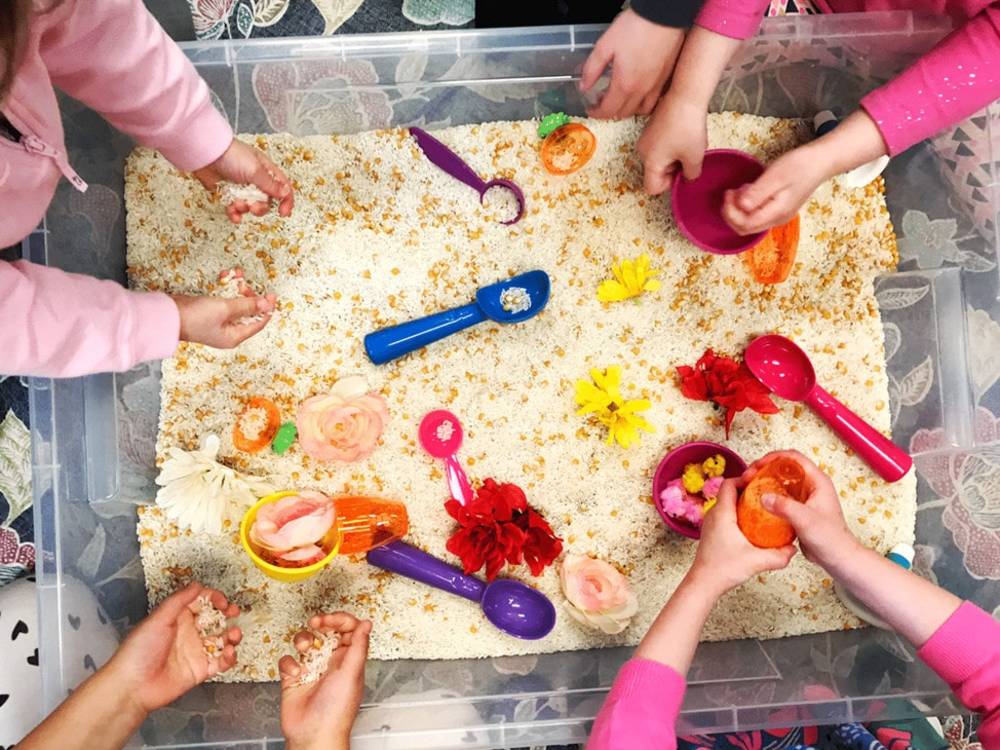
Image source: Artful Parent
Sensory bins are a great way to engage minds and spark imagination. Even as an adult, it can still be fun to put your hands into a bin while blindfolded and try to figure out what’s in it. There’s just something about the mystery of a sensory bin that captivates the mind.
Importantly, kids love exploring shapes, colours, and textures and trying to figure out what it all means.
Hands-on play improves fine motor skills, can increase social, communication, and sharing skills (if the entire group takes turns at guessing what’s in the bin), is great for language development (as they try to describe what they feel), and is fantastic for cognitive development (e.g. counting how many objects are in a bin).
What you need for a sensory bin
- The bin(s) itself: This can be one bin that everybody takes turns using or a bin for each child.
- Sensory bin fillers: The sensory bin ideas and options are endless, but can include cooked or dried pasta, cereals, dried rice, dirt, playdough, beans, water beads, shredded paper, moon sand, cotton balls, pipe cleaners, shaving cream, and packing peanuts.
- Things to spark imagination: You can also add objects to make the bin more existing. These could include plastic numbers, stuffed animals, pom poms, etc. The idea would be to have the kids sift through the other materials to find these objects and pull them out.
Example of a sensory bin activity
Give each child a sensory bin and fill it with coloured rainbow rice. These colours (shaped like a rainbow) add a pop of fun to the exploration they’re about to embark on.
Hide plastic letters at the bottom of the bins and tell them to find the hidden treasure and pull it out. After they find each letter (if they are old enough to have learned the alphabet) ask them to say what each letter is.
If they’re old enough to read and form words, have them try to create a word from the letters in their bin.
What will the children be learning?
They’ll be having tons of fun exploring new sights, textures, materials, and smells.
If you choose to have one bin and have each child take a turn and say what they feel out loud (or guess at what’s in the bin if they’re a bit older), they’ll learn the tenets of cooperative play, community, and group reflection.
By working on their vocabulary and expression, they’ll be expanding their phonological awareness, alphabet knowledge, speaking, comprehension, and reading skills.
5. Sensory bottle (calming bottle)
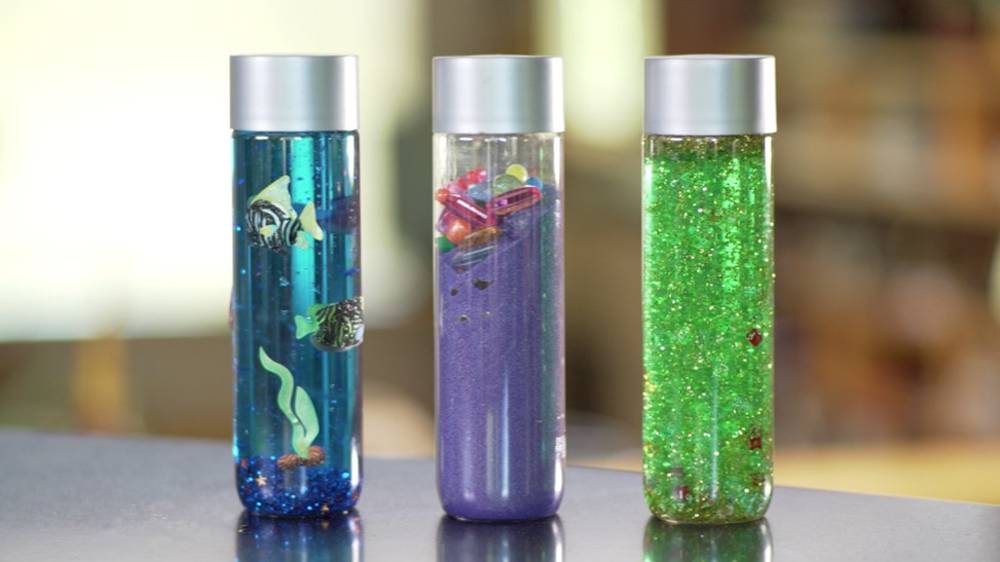
Image source: Understood.org
A sensory bottle can be incredibly mesmerising. It helps to calm children down and helps to regulate their emotions.
Depending on how you use the bottle, it can also help children learn new vocabulary, improve their fine and gross motor skills, learn key scientific tenets (i.e. floating, sinking, testing a hypothesis), and learn new sounds.
The idea of a sensory bottle is to fill it with whatever materials you want and have the child shake it and watch how the items slowly move around the bottle. This should calm their breathing if they are becoming outwardly upset, or simply work to shift a chaotic environment (perhaps after some fun food play) into a more harmonious one.
Importantly, sensory bottles can be used indoors or outdoors. And, they’re not messy, which is a nice departure from the sensory activities we’ve outlined thus far. They allow children to make sense of the world while keeping clean up to a minimum—a win-win!
What you need for a sensory bottle
- Bottle(s) and superglue: The safest and most secure bottle is a plastic bottle. You should avoid glass as that can easily break. Make sure to have super glue on hand to seal the bottle up once you’re done constructing it.
- Items for the bottle: Here’s where you can get super creative. You’ll need both liquids and solids for maximum effect. Liquids can be water, dish soap, baby oil, vegetable oil, corn syrup, food colouring, etc. Solid materials can include glitter, rice, sand, small toys, lego blocks, water beads, plastic letters, mini plastic toys.
- Things to spark imagination: In this case, most everything takes place inside the bottle, so no additional materials are needed. That said, you can certainly dress your bottle up to make it 3D, like adding arms and legs to a Halloween themed bottle to create a fun and spooky effect.
Example of a sensory bottle activity
Again, the options are quite endless here. For this example, let’s go with a ‘slow falling star’ theme.
To start, throw a few handfuls of plastic star beads into your plastic bottle and then fill it ¾ of the way with clear hand soap. Hand soap is thick, so it will make it difficult for the stars to move around quickly. Top it off with some dish soap to add some bubbles and ensure the stars can in fact make their way through the thick hand soap.
Add glitter or food colouring to the mix to add some more colours to the scene. Then, seal the lid with super glue so it can’t come off.
With your bottle complete, shake it up (or have your children shake it themselves if they are old enough) and sit back as they watch in awe. Ideally, the stars should slowly move up and down as if they are floating in the sky.
What will the children be learning?
A calming bottle can help children learn about science and the world around them. For example, you can have them hypothesise what will happen after the bottle is shaken and then test their predictions in the experiment (i.e. shaking the bottle and observing the outcome).
They can then draw conclusions about the characteristics of the bottle, why the objects move slowly, why they rise and fall, and so on.
Behaviourally, children will learn how to self-regulate their emotions. This will help them to build self-awareness and reflection as they move from an anxious or hyperactive state to a more calm and centred mental space.
Wrapping up
Sensory play is one of the most important tools you have in your childminder toolbox. It’s a critical part of physical, emotional, and behaviour development, and, importantly, can be tons of fun.
Before running any sensory play activities, make sure that you’ve dutifully prepared so that you have the necessary space, materials, resources, and recourse to ensure you’re creating a safe and secure environment. And, that you know exactly what to do should something go off course.
Then, leverage the activities laid out in this guide to spark the key developmental indicators that we’ve discussed and watch as your children grow through sensory play and exploration.
Curious about how tiney helps childminders leverage child-led playful learning in their business? Visit our website to take a look inside some of our tiney homes, learn more about our education philosophy, and get in touch with any questions.
